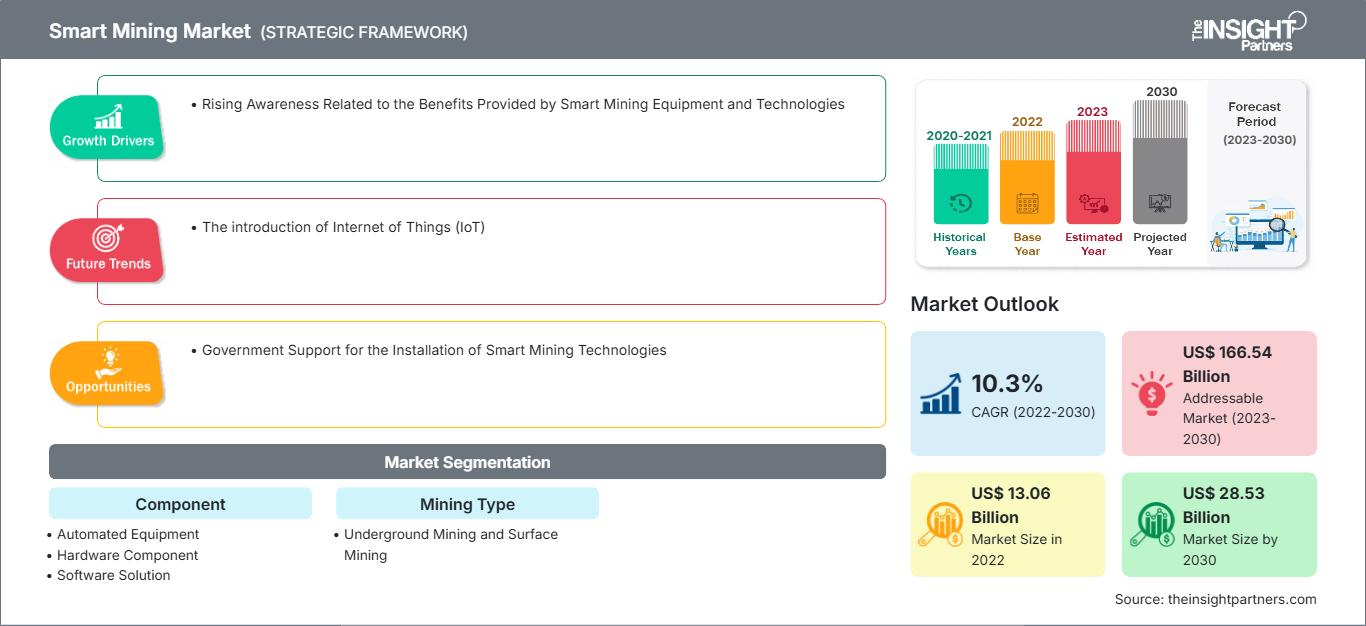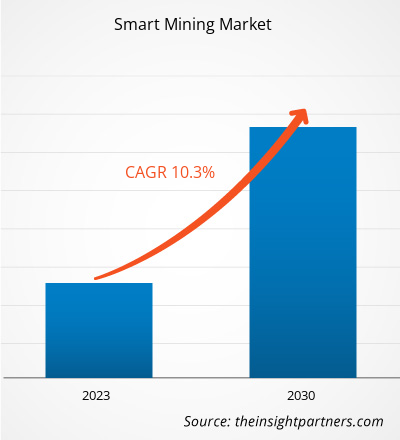스마트 마이닝 시장 규모는 2022년 130억 6천만 달러로 평가되었으며, 2030년에는 285억 3천만 달러에 이를 것으로 예상됩니다. 스마트 마이닝 시장은 2022년부터 2030년까지 연평균 성장률 10.3%를 기록할 것으로 예상됩니다. 사물 인터넷(IoT)의 도입은 시장의 주요 트렌드로 남을 것으로 보입니다.
스마트 마이닝 시장 분석
스마트 마이닝 장비 및 기술이 제공하는 이점에 대한 인식 제고와 인력 안전 확보에 대한 필요성 증가가 시장을 주도하고 있습니다. 데이터 보안 강화를 위한 기업들의 스마트 마이닝 구성 요소 수요 증가로 인해 예측 기간 동안 시장이 성장할 것으로 예상됩니다. 또한, 스마트 마이닝 기술 도입에 대한 정부 지원과 자동화된 마이닝 장비 도입 증가는 시장에 수익성 있는 기회를 창출하고 있습니다.
스마트 마이닝 시장 개요
스마트 마이닝은 광산 부문에서 연계 기술을 활용하는 것을 의미합니다. 이러한 기술에는 인터넷을 통해 서로 및 주변 환경과 통신하는 카메라, 센서, 드론이 포함됩니다. 장치 네트워크는 프로세스 자동화, 운영 간소화, 데이터 수집, 그리고 채굴 프로세스의 다양한 부분을 연결하는 데 도움을 줍니다. 스마트 채굴 기술은 광산의 효율성 향상, 비용 절감, 작업자 안전 보호, 그리고 오염 감소에 기여합니다.
요구 사항에 맞게 이 보고서를 사용자 정의하십시오.
이 보고서의 일부, 국가 수준 분석, Excel 데이터 팩을 포함하여 모든 보고서에 대한 사용자 정의를 무료로 받을 수 있을 뿐만 아니라 스타트업 및 대학을 위한 훌륭한 제안 및 할인을 이용할 수 있습니다
스마트 마이닝 시장: 전략적 통찰력

- 이 보고서의 주요 주요 시장 동향을 확인하세요.이 무료 샘플에는 시장 동향부터 추정 및 예측에 이르기까지 데이터 분석이 포함됩니다.
스마트 마이닝 시장 성장 동력 및 기회: 스마트 마이닝 장비 및 기술이 제공하는 이점에 대한 인식 제고로 시장 활성화
이 보고서의 일부, 국가 수준 분석, Excel 데이터 팩을 포함하여 모든 보고서에 대한 사용자 정의를 무료로 받을 수 있을 뿐만 아니라 스타트업 및 대학을 위한 훌륭한 제안 및 할인을 이용할 수 있습니다
스마트 마이닝 시장: 전략적 통찰력

- 이 보고서의 주요 주요 시장 동향을 확인하세요.이 무료 샘플에는 시장 동향부터 추정 및 예측에 이르기까지 데이터 분석이 포함됩니다.
전 세계는 광산업 발전을 위해 스마트 마이닝 기술을 모색하고 있습니다. 디지털화와 산업 자동화의 발전은 광업 기업의 운영 효율성을 향상하는 데 도움이 됩니다. 이러한 이점은 국가의 광업 활동 확장에 기여합니다. 예를 들어, 2023년 이탈리아 정부는 주요 원자재 채굴 작업 재개를 발표했습니다. 이 광산에는 리튬, 코발트, 니켈, 구리, 아연, 베릴륨, 텅스텐 등 다양한 광물이 매장되어 있습니다. 정부는 또한 이탈리아가 34가지 원소 중 최소 15가지를 지하에 보유하고 있다고 추정했습니다. 채굴 활동 재개를 위해서는 채굴 작업 효율을 높일 스마트 장비와 기술이 필요합니다. 이러한 스마트 마이닝 기술은 환경 영향을 최소화하여 근로자의 생산성을 향상하는 데 도움이 됩니다.
스마트 마이닝 기술 도입을 위한 정부 지원
정부는 또한 1,000개 이상의 가동 중인 석탄 시설에 스마트 마이닝 기술을 도입하여 연간 생산량을 6억 2천만 톤 이상으로 늘렸습니다. 또한, 중국은 2030년까지 온실가스 배출량 정점을 달성하기 위해 석탄 벨트 지역인 산시성에 홍류린(Hongliulin) "지능형 광산"을 구축하여 석탄 시설을 현대화하고 있습니다. 스마트 마이닝 기술의 지속가능성 이점은 중국 시장 성장을 촉진합니다. 따라서 예측 기간 동안 스마트 마이닝 시장 관련 인식 제고 프로그램, 컨퍼런스, 전시회 등의 증가는 성장 기회를 창출할 것으로 예상됩니다.
스마트 마이닝 시장 보고서 세분화 분석
스마트 마이닝 시장 분석 도출에 기여한 주요 부문은 구성 요소와 마이닝 유형입니다.
- 구성 요소를 기준으로 스마트 마이닝 시장은 자동화 장비, 하드웨어 구성 요소, 소프트웨어 솔루션, 서비스로 구분됩니다. 자동화 장비 부문은 화물 운반 덤프, 로봇 트럭, 드릴러 및 브레이커, 굴삭기 등으로 세분화됩니다. 하드웨어 구성 요소 부문은 RFID 태그, 센서, 지능형 시스템 등으로 세분화됩니다. 소프트웨어 솔루션 부문은 물류 소프트웨어 및 솔루션, 데이터 및 운영 관리 소프트웨어 및 솔루션, 안전 및 보안 시스템, 연결 솔루션, 분석 솔루션, 원격 관리 솔루션, 자산 관리 솔루션으로 세분화됩니다. 자동화 장비 부문은 2022년에 더 큰 시장 점유율을 기록했습니다.
- 채굴 유형을 기준으로 시장은 지하 채굴과 노천 채굴로 구분됩니다. 지하 채굴 부문은 2022년에 더 큰 시장 점유율을 기록했습니다.
지리적별 스마트 마이닝 시장 점유율 분석
스마트 마이닝 시장 보고서의 지리적 범위는 주로 북미, 아시아 태평양, 유럽, 중동 및 아프리카, 중남미의 5개 지역으로 나뉩니다.
유럽 시장은 채굴 활동 증가로 인해 예측 기간 동안 확대될 것으로 예상됩니다. 예를 들어, 2022년 10월, 이메리스 마이닝(Imerys Mining)은 프랑스에서 리튬을 채굴하는 EMILI(이메리스 리튬 마이카 채굴 프로젝트) 프로젝트를 시작했습니다. 이 프로젝트는 2028년부터 연간 34,000톤의 수산화리튬을 생산할 예정이며, 이는 프랑스와 유럽의 산업 주권을 향상시켜 리튬 배터리 생산량을 증대시킬 것입니다. 이 프로젝트들은 이메리스 마이닝이 에너지 전환 역량을 통합하고 강화하여 채굴 활동과 관련된 탄소 발자국을 줄이는 데 도움이 될 것입니다. 리튬 채굴은 광산의 효율성과 안전성을 높이기 위해 자율주행차와 로봇 시스템을 활용하는 경우가 많습니다. 프랑스의 스마트 채굴 기술 도입 증가는 스마트 채굴 시장 성장을 촉진할 것으로 예상됩니다.
스마트 채굴 시장스마트 마이닝 시장
The Insight Partners의 분석가들은 예측 기간 동안 스마트 마이닝 시장에 영향을 미치는 지역별 동향과 요인들을 면밀히 분석했습니다. 이 섹션에서는 북미, 유럽, 아시아 태평양, 중동 및 아프리카, 그리고 중남미 지역의 스마트 마이닝 시장 세분화 및 지역별 분포도 살펴봅니다.
스마트 마이닝 시장 보고서 범위
| 보고서 속성 | 세부 |
|---|---|
| 시장 규모 2022 | US$ 13.06 Billion |
| 시장규모별 2030 | US$ 28.53 Billion |
| 글로벌 CAGR (2022 - 2030) | 10.3% |
| 이전 데이터 | 2020-2021 |
| 예측 기간 | 2023-2030 |
| 다루는 세그먼트 |
By 구성 요소
|
| 포함된 지역 및 국가 | 북미
|
| 시장 선도 기업 및 주요 회사 프로필 |
|
스마트 마이닝 시장 참여자 밀도: 비즈니스 역학에 미치는 영향 이해
스마트 마이닝 시장은 소비자 선호도 변화, 기술 발전, 그리고 제품 이점에 대한 인식 제고 등의 요인으로 인한 최종 사용자 수요 증가에 힘입어 빠르게 성장하고 있습니다. 수요가 증가함에 따라 기업들은 제품 및 서비스 확장, 소비자 니즈 충족을 위한 혁신, 그리고 새로운 트렌드를 적극 활용하며 시장 성장을 더욱 가속화하고 있습니다.

- 을 얻으세요 스마트 마이닝 시장 주요 주요 플레이어 개요
스마트 마이닝 시장은 1차 및 2차 조사 후 주요 기업 간행물, 협회 데이터, 데이터베이스 등 정성적 및 정량적 데이터를 수집하여 평가합니다. 스마트 마이닝 시장의 몇 가지 동향은 다음과 같습니다.
- 광산 업계의 선두 주자인 이 회사는 ABB Ability Operations Management System & (OMS 41; 퍼스 북동쪽 740km에 있는 광산. OMS는 Granny Smith 운영의 GoldField 디지털 변환에 기여하여 생산성을 개선하고 데이터 흐름을 간소화하여 시기적절한 의사 결정을 가능하게 합니다. 약 160만 톤의 금이 함유된 광석이 지하 광산에서 추출되어 현장의 가공 공장에서 처리됩니다. (출처: ABB Ltd, 회사 웹사이트, 2023년 9월)
스마트 마이닝 시장 보고서 범위 및 제공물
“스마트 마이닝 시장 규모 및 예측(2020~2030)” 보고서는 아래 영역을 포괄하는 시장에 대한 자세한 분석을 제공합니다.
- 범위에 포함된 모든 주요 시장 부문에 대한 글로벌, 지역 및 국가 수준의 스마트 마이닝 시장 규모 및 예측
- 스마트 마이닝 시장 동향 및 동인, 제약 및 핵심과 같은 시장 역학 기회
- 상세한 PEST/포터의 5가지 힘 및 SWOT 분석
- 주요 시장 동향, 글로벌 및 지역 프레임워크, 주요 참여자, 규정 및 최근 시장 동향을 다루는 스마트 마이닝 시장 분석
- 시장 집중도, 히트맵 분석, 주요 참여자 및 스마트 마이닝 시장의 최근 동향을 다루는 산업 환경 및 경쟁 분석
- 상세한 회사 프로필
- 과거 분석(2년), 기준 연도, CAGR을 포함한 예측(7년)
- PEST 및 SWOT 분석
- 시장 규모 가치/거래량 - 글로벌, 지역, 국가
- 산업 및 경쟁 환경
- Excel 데이터세트
최근 보고서
관련 보고서
사용 후기
구매 이유
- 정보에 기반한 의사 결정
- 시장 역학 이해
- 경쟁 분석
- 고객 인사이트
- 시장 예측
- 위험 완화
- 전략 기획
- 투자 타당성 분석
- 신흥 시장 파악
- 마케팅 전략 강화
- 운영 효율성 향상
- 규제 동향에 발맞춰 대응




















 무료 샘플 받기 - 스마트 마이닝 시장
무료 샘플 받기 - 스마트 마이닝 시장